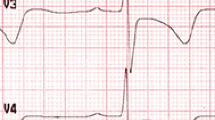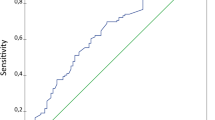Abstract
Background
Association between electrocardiography (ECG) features and right ventricular anatomy and physiology has been established. This study is aimed to identify the value of 12-lead ECG in evaluating prognosis of patients with idiopathic pulmonary arterial hypertension (IPAH).
Method
194 patients with newly diagnosed IPAH were included in this study. Correlations between electrocardiography variables and hemodynamics were assessed. Univariate and multivariable cox regression analysis were performed to identify ECG variables for predicting all-cause mortality in IPAH.
Results
Partial correlation analysis showed that P wave amplitude in lead II correlated with the mean pulmonary arterial pressure (mPAP, r = 0.349, p ≤ 0.001) and cardiac index (CI, r = −0.224, p = 0.002); R wave amplitude in V1 correlated with mPAP (r = 0.359, p ≤ 0.001); S wave amplitude in V6 correlated with mPAP (r = 0.259, p = 0.030) and CI (r = −0.220, p = 0.003). P wave amplitude in lead II (HR 1.555, p = 0.033) and R wave amplitude in lead aVR (HR 5.058, p < 0.001) were the independent predictors of all-cause mortality. Kaplan–Meier survival curves showed patients with a p ≥ 0.25 mv in lead II, and R ≥ 0.4 mv in lead aVR had lower 3-year survival (55 vs. 91%, p < 0.001).
Conclusion
Specific lead-12 ECG features could reflect right ventricular overload hemodynamics, and are useful to evaluate prognosis of patients with IPAH.





Similar content being viewed by others
References
Krowka MJ, Miller DP, Barst RJ et al (2012) Portopulmonary hypertension: a report from the US-based reveal Registry. Chest 141(4):906–915
Barst RJ, Gibbs JS, Ghofrani HA et al (2009) Updated evidence-based treatment algorithm in pulmonary arterial hypertension. J Am Coll Cardiol 54(1 Suppl):S78–S84
Kopec G, Tyrka A, Miszalski-Jamka T et al (2012) Electrocardiogram for the diagnosis of right ventricular hypertrophy and dilation in idiopathic pulmonary arterial hypertension. Circ J 76(7):1744–1749
Al-Naamani K, Hijal T, Nguyen V et al (2008) Predictive values of the electrocardiogram in diagnosing pulmonary hypertension. Int J Cardiol 127(2):214–218
Simonneau G, Galiè N, Rubin LJ et al (2004) Clinical classification of pulmonary hypertension. J Am Coll Cardiol 43(12 Suppl S):5S–12S
Badagliacca R, Poscia R, Pezzuto B et al (2016) Right ventricular concentric hypertrophy and clinical worsening in idiopathic pulmonary arterial hypertension. J Heart Lung Transplant. doi:10.1016/j.healun.2016.04.006
Roman G, Walsh T, Massie E (1961) Right ventricular hypertrophy: correlation of electrocardiographic and anatomic findings. Am J Cardiol 7:481–487
Lehtonen J, Sutinen S, Ikaheimo M et al (1988) Electrocardiographic criteria for the diagnosis of right ventricular hypertrophy verified at autopsy. Chest 93(4):839–842
Martínez Santos P, Vilacosta I, Batlle López E et al (2016) Surface electrocardiogram detects signs of right ventricular pressure overload among acute-decompensated heart failure with preserved ejection fraction patients. J Electrocardiol. doi:10.1016/j.jelectrocard.2016.02.021
Henkens IR, Gan CT, van Wolferen SA et al (2008) ECG monitoring of treatment response in pulmonary arterial hypertension patients. Chest 134(6):1250–1257
Myers GB, Klein HA, Stofer BE (1948) The electrocardiographic diagnosis of right ventricular hypertrophy. Am Heart J 35(1):1–40
Sokolow M, Lyon TP (1949) The ventricular complex in right ventricular hypertrophy as obtained by unipolar precordial and limb leads. Am Heart J 38(2):273–294
Hancock EW, Deal BJ, Mirvis DM et al (2009) American Heart Association Electrocardiography and Arrhythmias Committee, Council on Clinical Cardiology; American College of Cardiology Foundation; Heart Rhythm Society. AHA/ACCF/HRS recommendations for the standardization and interpretation of the electrocardiogram: part V: Electrocardiogram changes associated with cardiac chamber hypertrophy: A scientific statement from the American Heart Association Electrocardiography and Arrhythmias Committee, Council on Clinical Cardiology; the American College of Cardiology Foundation; and the Heart Rhythm Society: Endorsed by the International Society for Computerized Electrocardiology. Circulation 119(10):e251–e261
Nickel N, Golpon H, Greer M et al (2012) The prognostic impact of follow-up assessments in patients with idiopathic pulmonary arterial hypertension. Eur Respir J 39(3):589–596
Sitbon o, Humbert M, Nunes H et al (2002) Long-term intravenous epoprostenol infusion in primary pulmonary hypertension: prognostic factors and survival. J Am Coll Cardiol 40(4):780–788
Bossone E, Paciocco G, Iarussi D et al (2002) The prognostic role of the ECG in primary pulmonary hypertension. Chest 121(2):513–518
Badesch DB, Raskob GE, Eliot CG et al (2010) Pulmonary arterial hypertension: baseline characteristics from the reveal registry. Chest 137(2):376–387
Humbert M, Sitbon O, Chaouat A et al (2006) Pulmonary arterial hypertension in France results from a national registry. Am J Respir Crit Care Med 173(9):1023–1030
Jia WB, Jiang X, Zuo XR et al (2012) Clinical characteristics of 161 Chinese patients with idiopathic pulmonary arterial hypertension. Zhong hua Xin Xue Guan Bing Za Zhi 40(8):652–656
Wen L, Sun ML, An P et al (2014) Frequency of supraventricular arrhythmias in patients with idiopathic pulmonary arterial hypertension. Am J Cardiol 114(9):1420–1425
Acknowledgements
This study was supported by National Key Technology R&D Program, China (Project No.: 2011BAI11B15).
Author information
Authors and Affiliations
Corresponding author
Ethics declarations
Conflict of interest
The authors have no conflicts of interest to disclose.
Rights and permissions
About this article
Cite this article
Cheng, XL., He, JG., Liu, ZH. et al. The Value of the Electrocardiogram for Evaluating Prognosis in Patients with Idiopathic Pulmonary Arterial Hypertension. Lung 195, 139–146 (2017). https://doi.org/10.1007/s00408-016-9967-z
Received:
Accepted:
Published:
Issue Date:
DOI: https://doi.org/10.1007/s00408-016-9967-z




